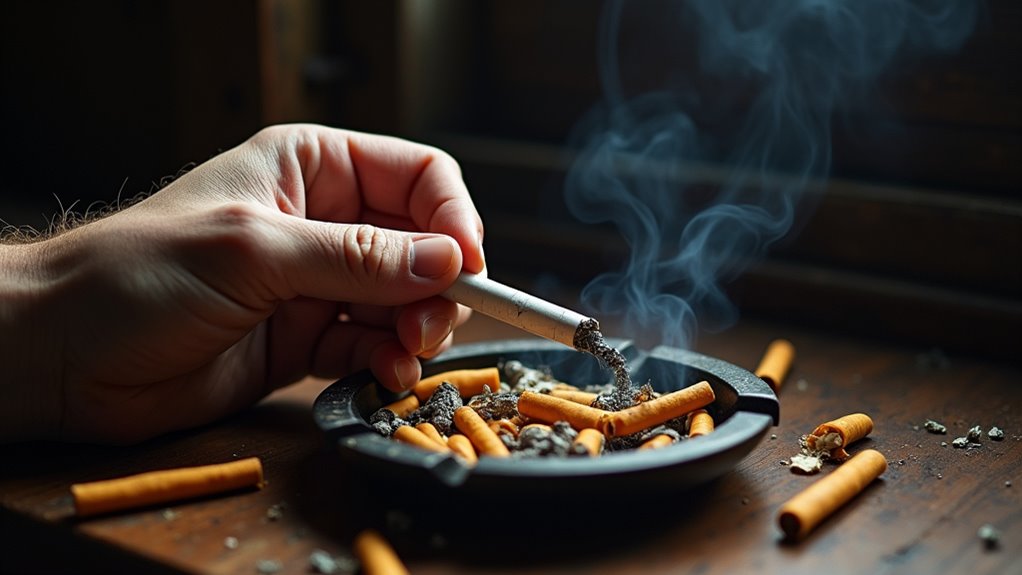You’re likely experiencing nicotine addiction if you smoke within 30 minutes of waking, consume more than 10 cigarettes daily, or feel intense cravings every couple of hours. Physical signs include withdrawal symptoms like trouble concentrating and sleep disruption, while financial strain from regular purchases might be affecting your budget. Social withdrawal and reduced family interactions often complete the picture. Understanding these warning signs is your initial step in the direction of addressing tobacco dependence.
The Morning Rush: Why Your First Cigarette Timing Matters

While many smokers track their daily cigarette count, the timing of their initial cigarette after waking (TTFC) proves to be an even more vital indicator of cancer risk and nicotine dependence.
Recent research examining 1,945 adult smokers shows the widespread nature of early-morning smoking habits.
Many smokers experience intense cravings with their morning coffee, as dark roasted coffee can interact directly with nicotine receptors in the brain.
If you’re lighting up within 30 minutes of waking, you’re facing a 79% higher risk of lung cancer and a 59% increased risk of head and neck cancer compared to waiting an hour or longer.
Your morning cravings aren’t just about habit they’re revealing important information about your addiction level.
Those morning urges for nicotine tell a deeper story they’re a window into how strongly addiction has taken hold.
Even with identical smoking intensity throughout the day, earlier TTFC correlates with doubled levels of NNAL, a tobacco-specific carcinogen in your system.
According to the study data, non-Hispanic white participants were more likely to smoke immediately after waking compared to other ethnic groups.
This heightened exposure occurs regardless of how many cigarettes you smoke daily.
Your initial-cigarette timing serves as a powerful predictor of both your addiction severity and cancer susceptibility.
Beyond Pack-a-Day: Understanding Your Daily Consumption

Although smoking patterns have evolved dramatically since the 1970s, understanding your daily cigarette consumption remains essential for evaluating health risks and addiction severity.
Today’s smoking trends show a significant shift in the direction of lighter consumption, with most smokers now using fewer than 15 cigarettes daily, compared to the heavy smoking patterns of previous decades. In fact, only 5.9% of adults across the European Union consume 20 or more cigarettes per day.
Your daily habits matter more than you might think. If you’re smoking more than 24 cigarettes daily, you’re now among just 8% of smokers who maintain heavy consumption patterns.
Most smokers have moved to medium (15-24 cigarettes) or light (<15 cigarettes) daily use. This dramatic shift is evidenced by an 85% increase in the proportion of people smoking fewer than 15 cigarettes per day. This change reflects broader changes in smoking behavior, with average daily consumption dropping from 13.6 to 10.6 cigarettes between 2008 and 2019.
Understanding where you fall on this spectrum can help gauge your addiction level.
Physical Signs Your Body Is Hooked on Nicotine

Physical addiction to nicotine manifests through clear, observable signs that indicate your body’s dependence.
You’ll notice intense physical cravings within two hours of your last cigarette, and these urges typically peak during the initial 2-3 days of attempting to quit. Your body may demand increasingly more tobacco to achieve the same satisfaction level, signaling growing tolerance to nicotine. Trouble concentrating commonly occurs as withdrawal sets in. Research shows nicotine addiction can develop after one use, making it crucial to avoid experimentation.
The rapid absorption of nicotine into your bloodstream affects brain chemistry. Withdrawal symptoms can include flu-like sensations, persistent headaches, and unexpected dizziness.
You might experience disrupted sleep patterns, including difficulty falling asleep and frequent nighttime awakenings. Changes in appetite often occur, leading to weight gain as your body adjusts.
These physical signs, combined with emotional symptoms like irritability and anxiety, clearly demonstrate how nicotine has altered your body’s normal functioning.
Breaking the Bank: The Financial Impact of Smoking
The staggering financial burden of smoking extends far beyond the price tag on cigarette packs. If you’re spending 24% of your income on cigarettes in high-tax regions, you’re experiencing severe financial strain that impacts your entire household. As a pack-a-day smoker, you’re investing over $2,250 annually in a habit that diminishes your financial security.
Consider these sobering realities of smoking costs:
- You’re diverting funds from essential needs like food, healthcare, and your children’s future.
- Your smoking expenses could instead fund retirement, education, or emergency savings.
- You’re facing potential lifetime costs exceeding $200,000, not including healthcare expenses.
This financial pressure often creates a vicious cycle: you’re more likely to want to quit but less likely to succeed due to economic stress, making professional support vital for breaking free.
When Social Life Takes a Back Seat to Smoking
Beyond draining your wallet, smoking progressively erodes your social connections and relationships. You’ll experience increasing social withdrawal as smoking breaks disrupt your daily interactions and limit participation in smoke-free venues. Recent research shows that breathlessness and illness can significantly impact your ability to maintain an active social life. Studies indicate chronic inflammation makes smokers more vulnerable to ongoing health issues. A groundbreaking English study reveals that current smokers experience significantly higher rates of social isolation compared to non-smokers.
| Social Impact | Loneliness Effects |
|---|---|
| 40% higher chance of living alone | Equivalent health risk to smoking 15/day |
| Reduced family interactions | Increased cardiovascular risks |
| Limited cultural participation | Accelerated social isolation |
Your addiction creates a destructive cycle: smoking leads to isolation, which triggers more smoking as a coping mechanism. You’ll find yourself avoiding group activities that restrict smoking, withdrawing from shared hobbies, and preferring solitary environments. This pattern of disengagement intensifies over time, with research showing smokers face considerably higher baseline loneliness and declining community involvement compared to non-smokers.
Frequently Asked Questions
Can Nicotine Addiction Be Hereditary or Passed Down Through Family Genes?
Yes, you can inherit a genetic predisposition to nicotine addiction.
Research shows that 40-70% of your risk for developing nicotine dependence comes from your genes. If you have a family history of smoking addiction, you’re more likely to develop dependence and experience faster progression to regular smoking.
Your genetic makeup can affect how quickly you metabolize nicotine and how strongly you respond to its effects, influencing your addiction risk.
How Long Does Nicotine Stay Detectable in Blood After Quitting Smoking?
After you quit smoking, nicotine metabolism occurs rapidly, with the substance remaining detectable in your blood for only 1-3 days.
However, blood testing can identify cotinine (nicotine’s main metabolite) for up to 10 days post-cessation.
Your individual detection window depends on factors like usage frequency, metabolism rate, and genetic makeup.
For the most accurate assessment, healthcare providers typically test for cotinine rather than nicotine itself.
Does Smoking Electronic Cigarettes Make It Harder to Quit Regular Cigarettes?
Yes, vaping effects can actually make it harder to quit regular cigarettes.
When you use e-cigarettes, you’re maintaining nicotine dependency through a different delivery method, which can complicate your quitting challenges. Research shows you’re 28% less likely to successfully quit smoking if you use e-cigarettes.
Furthermore, dual use of both products may increase your total nicotine intake, potentially strengthening addiction and making cessation even more difficult.
What Percentage of Smokers Successfully Quit on Their First Attempt?
Based on reliable research data, you have about an 11% chance of successfully quitting smoking on your initial serious attempt.
This means approximately 89% of smokers will experience relapse rates that necessitate multiple attempts. If you’re measuring success by 6+ months of abstinence, your chances drop to roughly 8%.
Don’t be discouraged by these statistics they simply highlight why most people require several attempts before achieving long-term success in quitting smoking.
Can Certain Foods or Supplements Help Reduce Nicotine Cravings Naturally?
Yes, you can effectively manage nicotine cravings through strategic dietary choices and herbal remedies.
Crunchy foods like carrots and celery help replace the hand-to-mouth smoking motion, while dairy products can make cigarettes taste unpleasant.
You’ll find that vitamin-rich foods replenish nutrients depleted by smoking, and supplements like ginseng tea may reduce cravings by suppressing dopamine.
Black pepper essential oil and magnesium-rich foods like almonds can also minimize withdrawal symptoms naturally.






